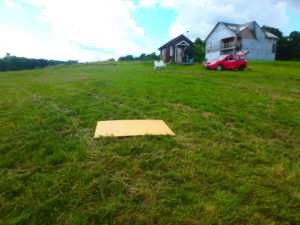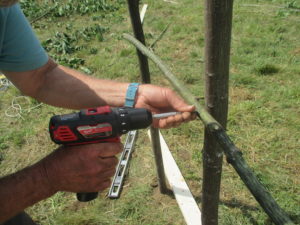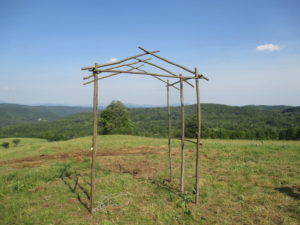Five Tips for Building a Garden Arbor
When I was a beginning gardener, I just planted vegetables in one place, flowers in another, and never spent 2 minutes thinking about the overall design. I was growing veggies to eat, flowers to admire or to cut and arrange in bouquets. But reading gardening books and and visiting fine gardens made I realize that overall design is important.
One feature of an alluring garden is a dramatic entrance. For the past 20 years or more I‘ve had a series of garden arbors that invite visitors to pass through to see what lies on the other side. I’ve made bentwood arbors of saplings and, more recently, simple Japanese-style arbors of cedar or striped maple (Acer pennsylvanicum).
You can build a nice entrance to your garden, or a garden room, for virtually no cost. If you have a supply of 2-inch diameter hardwood saplings, you can build one for the cost of a few wood screws and a scrap of plywood. But it will only last a couple of years. I built one recently for a wedding using saplings, as it only needed to be perfect for a day.
Alternatively you can buy cedar posts and build something that will last for 10 years or more. I’ve done both, and favor the investment in cedar, particularly if you are going to grow perennial woody vines over this arbor/trellis.
The type of cedar posts I’ve used have been made round with some sort of big machine, and have narrower cylindrical tips on each end designed to fit into vertical posts. I cut off the tips, making them about 8 feet long. Unlike rustic cedar posts used for attaching fencing, these have the bark removed, which is good. Bark promotes rot.
Tip #1: Decide on the size you need, and cut a piece of scrap plywood to that size. The plywood guarantees that the finished product will have the vertical posts arranged in a rectangle or square, and not a diamond or a rhombus. If you are making a permanent structure and it is surrounded by lawn, be sure it is wide enough for your lawnmower to pass through, with a little extra space for plants.
Tip #2: Get a post hole digger. This is a dandy 2-handed device that allows you to scoop out soil relatively easily. It makes a 6- or 8-inch diameter hole, which you could not do with a shovel. Dig holes a foot deep to give a nice sturdy feel to your arbor. I put a few small stones (the size of golf balls) in each hole alongside the posts and jam them in with a hand tool.
You can build an arbor with 4 or 6 upright posts. For smaller diameter posts (using saplings), I prefer using 6 posts. The more substantial cedar posts only need 4 posts, one on each corner. Something 4 to 5 feet wide and 4 feet from front to back is a nice size.
Tip # 3: You are not building a violin. It is easy to get obsessed with making every post absolutely vertical, and every horizontal precisely level. But, especially for arbors made of saplings, each piece is slightly different. Some have little curves, others have lumps and bumps. Work with a helper so one of you can adjust your posts to look good – standing straight up, with roughly level cross pieces. So long as it looks good to your eye, it is fine.
Tip #4: Pre-drill where you want to screw 2 pieces together. Borrow a second cordless drill, so you have one with a drill bit, one with a driver bit for Phillips screws. Use screws long enough to go through one piece, and at least an inch into the other. Have a variety of lengths available.
Each side needs 3 horizontal braces that are held in place with screws or lag bolts. Install one a couple of inches below the top, to hold the rafters; one at waist height, say 36 inches off the ground; one 8 to 10 inches off the ground. I usually add a few pieces running vertically from the middle to the lower cross pieces.
If you can’t get smaller-sized cedar posts for the rafters and cross pieces, you can use 2 by 2 inch rough-sawn lumber, either cedar or hemlock. Once vines are growing on them, you will never notice that they’re not round. The alternative, using maple branches, looks great, but the wood will fall apart in a much shorter time, probably 3 years.
Tip # 5: To build the top, where I have 3 pairs of rafters, join 2 rafters together with an 8-inch overlap. Hold 2 pieces in place to see how long your rafters need to be. Then screw through the two pieces 8 inches from the top. With a helper on one side and you on the other, hold the rafters in place. I like a “tail” that hangs over the top cross piece- anywhere from 8 to 16 inches. Then screw down through the rafter on one side, measure the tail to be the same on the other, and screw it down. I like a nice low “roof angle” for a Japanese look.
This all may sound difficult, but it really isn’t, and it will please you for years to come. If you build one, please send me a photo. Depending on your skills, you can build an arbor like this in a day – or perhaps a weekend.
Two workers certainly make sense, though I have built one by myself. I love building things, and this type of arbor is elegant and pleasing to the eye.
You may reach Henry at henry.homeyer@comcast.net or P.O. Box 364, Cornish Flat, NH 03746. He is the author of 4 gardening books and is happy to coach new and experienced gardeners.







